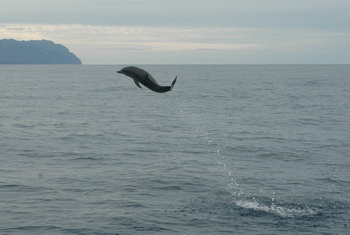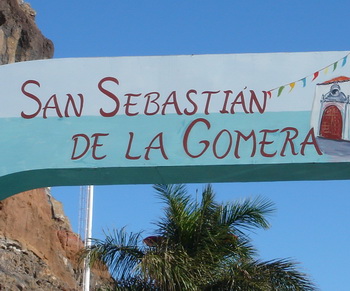
La Gomera
Canary Islands
December 2008
Part One
| |
| HOME |
| About Tenaya |
| About Us |
| Latest Update |
| Logs from Current Year |
| Logs from Previous Years |
| Katie's View |
| Route Map |
| Links |
| Contact Us |
![]()
December 4, 2008
Just before sunrise Tenaya edged her way out of Santa Cruz de la Palma with hardly a breath of wind and not much forecasted for the day. The sea was calm with no other boats, inspiring tranquility aboard. A little haze kept the sky from a brilliant blue as we could see Tenerife, La Palma, El Hierro and our destination, La Gomera.
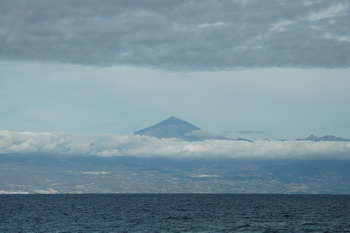
El Teide, the highest point in Spain.
Early afternoon we were joined by several dolphins darting back and forth under Tenaya and frolicking alongside her bow. More and more joined in and soon there were more than 20. Most were fairly sedate but one was exceptionally athletic and would jump high into the air, spinning and twisting, in sets of three jumps. Incredible!
Click picture to see dolphin video
or

Dolphins joined us for a while
After a peaceful and enjoyable trip we arrived at San Sebastian de la Gomera on Saturday, November 29, after motoring 59 miles in 8 hours 45 minutes.

San Sebastian de la Gomera
San Sebastian is the capital of La Gomera and is more a town than a city. The small, pleasant town center begins across the street from the marina. Markets, bakeries and restaurants are within close walking distance. It is a relaxing place to spend time before embarking on a long voyage.
We recognize many boats here that we have previously seen either at other islands in the archipelago or in the Mediterranean. Francois and Annick of Alila and Bob and Liz of Yanina are among them.
Bob's hilarious book, ON THE NOSE, has been published and his cartoons are appearing in Yachting Monthly and Latitudes and Attitudes. They joined us for dinner aboard Tenaya on the magical evening when the moon was accompanied closely by Venus and Jupiter.
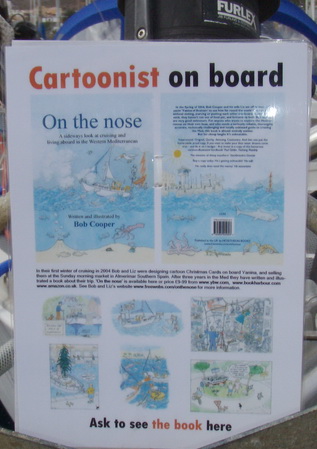
ON THE NOSE is selling like hotcakes! What a great Christmas gift.
Go to Bob's ON THE NOSE website
La Gomera has a reputation among sailors as a pretty island to visit and a good departure point for heading across the Atlantic to Brazil or the Caribbean. A stopping point for centuries, Christopher Columbus embarked on his voyage to the New World from here. Twice.

The church where Columbus and his crew heard mass before their voyages to the New World
.
The small, round island is mountainous, relatively wild and sparsely populated. Deep ravines run from the high center of the island like enormous wrinkles all around it down to the sea. Most of the towns and villages are located at the base of these ravines. Today we rented a car to have a look.
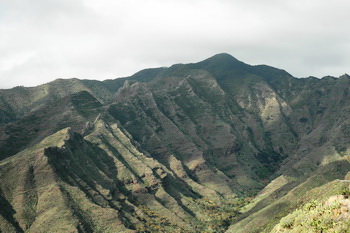
Ravines radiate like spokes from the center of the island
Volcanic in origin, the last eruption occurred over 2 million years ago. The volcanos are all but gone having eroded away leaving only the plugs which are known as roques.

A roque, the only remains of a volcano
People have been terracing the hills and steep canyon walls for centuries. Bananas and citrus are grown in the lower elevations and potatoes and corn in the higher.
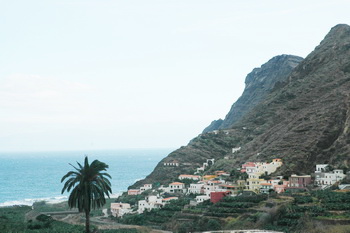
The town of Lepe sits among the terraces
At the center of the island, high above sea level, lie forests of laurel and wax myrtle-heath. They are protected in the Garajonay National Park, a UNESCO World Heritage site.
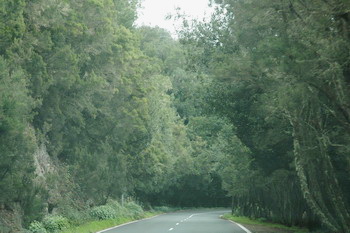
A road runs through the forests of Garajonay National Park
The vegetation varies greatly on La Gomera depending on location. High in the mountains the forests are dense and the atmosphere is misty and humid. Closer to the ocean both the land and air are much drier.

Cactus and brush grow in the lower elevations

Black sand and pebble beaches abound

Playa Santiago
.
Within the next few days we will depart San Sebastian de la Gomera to cross the Atlantic. Heading SSW toward the Cape Verde Islands, we will turn W when we encounter the trade winds, somewhere around 20 degrees N, and keep going until we reach Barbados.
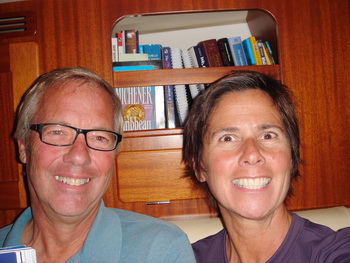
This classic trade wind route is favored by most skippers heading W from Europe. Although much has been learned about weather forecasting and wind patterns of the Atlantic Ocean in the 500 years since Columbus sailed from here, his route remains basically unchanged. It won't get you to India, as he thought, but the Caribbean is a darn nice place! His two fastest passages took 21 days. If all goes well, our voyage should not take many more days.
We will update the site again from the Caribbean in January. We wish you a Merry Christmas.
December 15 PS: Actually we made an unplanned stock for repairs in the Cape Verde Islands and were able to update our site.
.
